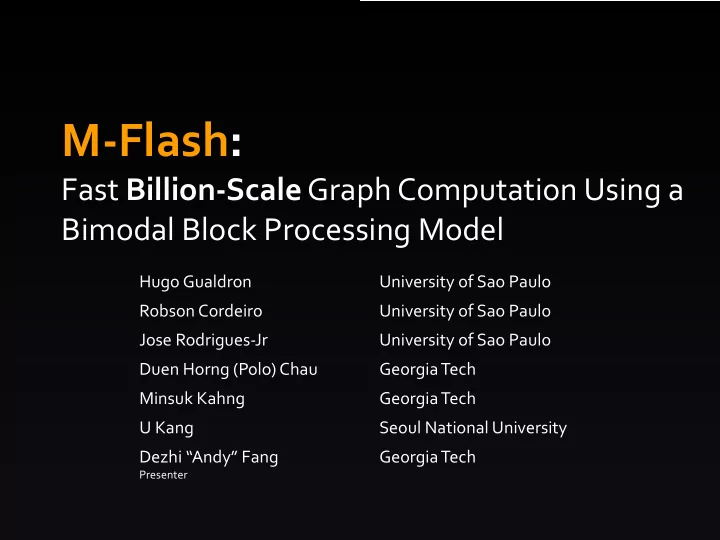

M-Flash: Fast Billion-Scale Graph Computation Using a Bimodal Block Processing Model Hugo Gualdron University of Sao Paulo Robson Cordeiro University of Sao Paulo Jose Rodrigues-Jr University of Sao Paulo Duen Horng (Polo) Chau Georgia Tech Minsuk Kahng Georgia Tech U Kang Seoul National University Dezhi “Andy” Fang Georgia Tech Presenter
Internet 4+ Billion Web Pages www.worldwidewebsize.com www.opte.org 2
Citation Network 250+ Million Articles www.scirus.com/press/html/feb_2006.html#2 Modified from well-formed.eigenfactor.org 3
Many More § Twitter Who-follows-whom (310 million monthly active users) Who-buys-what (300+ million users) cellphone network § Who-calls-whom (130+ million users) Protein-protein interactions 200 million possible interactions in human genome Sources: www.selectscience.net www.phonedog.com www.mediabistro.com www.practicalecommerce.com 4
Large Graphs Are Common Graph Nodes Edges YahooWeb 1.4 Billion 6 Billion Symantec Machine-File Graph 1 Billion 37 Billion Twitter 104 Million 3.7 Billion Phone call network 30 Million 260 Million Takes Most Space 5
Scalable Graph Computation on Single Machines PageRank Runtime (s) on Twitter Graph (1.5 billion edges; 10 iterations, lower is better) Spark 428.5 Today’s single machines 128 Giraph 298 are very powerful. Cores GraphX 209.5 GraphChi 1248 Single TurboGraph 198 Machine MMap 131 (4 cores) 0 500 1000 1500 Can we do even better? McSherry, Frank, Michael Isard, and Derek G. Murray. "Scalability! But at what COST?." 15th Workshop on Hot Topics in Operating Systems (HotOS XV). 2015. Lin, Zhiyuan, et al. "Mmap: Fast billion-scale graph computation on a pc via memory mapping." Big Data (Big 6 Data), 2014 IEEE International Conference on. IEEE, 2014.
M-Flash: Fast Billion-Scale Graph Computation Using a Bimodal Block Processing Model 7
Our Observation #1: I/O is Bottleneck Graph edges need to be stored on disk. Symantec graph: 37 billion edges, 200+ GB Disk access is much slower than RAM. Goal: Reduce I/O, especially random accesses 8
Our Observation #2: Real-world graphs are sparse. Adjacency matrix contains dense and sparse blocks https://web.stanford.edu/class/bios221/labs/networks/lab_7_networks. html Sparse Blocks Dense Blocks 9
M-Flash’s Solutions 1. Determine edge block types (dense and sparse) 2. Design efficient processing approaches for each block type 10
Determine Block Types In Pre-processing Sparse Sparse Sparse Dense Sparse, if I/O cost if treated as Sparse I/O cost if treated as Dense < 1 BlockType = Dense, otherwise 11
Dense Block Processing (Assuming all blocks are dense) = x New vertex values Old vertex values 12
I/O Cost for Dense Block Processing Each vertex is read 𝛾 times # Edge # Vertex and then written once O( 𝛾 + 1 𝑊 + 𝐹 Type equation here. + 𝛾 9 ) 𝐶 #Interval Size of per I/O Operation (= #Row = #Column) 13
Sparse Block Processing (Assuming all blocks are sparse) Destination Source Partition 1 Source Partition: Sequential Read Source Partition 2 14
Sparse Block Processing (Assuming all blocks are sparse) Destination Destination Partition 1 Partition 2 Destination Partition: Sequential Write Source 15
I/O Cost for Sparse Block Processing Edge with extended information # Vertex # Edge Type equation here. O(2 𝑊 + 𝐹 + 2|𝐹 =>?=@A=A | + 𝛾 9 ) 𝐶 #Interval Size of per I/O Operation (= #Row = #Column) 16
Bimodal Block Processing Sparse Sparse Sparse Dense Sparse, if I/O cost if treated as Sparse I/O cost if treated as Dense < 1 BlockType = Dense, otherwise 17
Large Graphs Used in Evaluation Graph Nodes Edges 5 Million 69 Million LiveJournal 41 Million 1.5 Billion Twitter 1.4 Billion 6.6 Billion YahooWeb 4 Billion 12 Billion R-Mat (Synthetic) 18
Runtime of M-Flash PageRank Runtime (s) on 6 billion edge YahooWeb Graph (1 iteration, shorter is better) 4GB M-Flash Memory MMap Size 8GB TurboGraph X-Stream GraphChi 16GB 0 1000 2000 3000 19
Dezhi “Andy” Fang Georgia Tech CS Undergrad M-Flash: http://andyfang.me Fast Billion-Scale Graph Computation Using a Bimodal Block Processing Model • Fastest single-node graph computing framework • Innovative bimodal design that addresses varying edge density in real-world graphs • M-Flash Code: https://github.com/M-Flash/m-flash-cpp • MMap Project: http://poloclub.gatech.edu/mmap/ CNPq (grant 444985/2014-0), Fapesp (grants 2016/02557-0, 2014/21483-2), Capes, NSF (grants IIS- 1563816, TWC-1526254, IIS-1217559) GRFP (grant DGE-1148903), Korean (MSIP) agency IITP (grant R0190-15-2012) 20
Recommend
More recommend